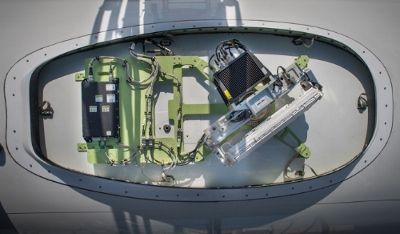PHOENIX, Aug. 23, 2016 /PRNewswire/ — Honeywell (NYSE: HON) achieved final certification from Inmarsat for JetWave™, the company’s package of exclusive hardware that will allow pilots, passengers, operators and maintenance personnel to connect to GX Aviation, the revolutionary new in-flight broadband service from Inmarsat. Users can consistently and more quickly surf the internet, check emails, stream music and videos, and shop online without drop-off throughout their flight, even when flying over oceans.
JetWave has also been certified by the Federal Aviation Administration and European Aviation Safety Agency for safety, environmental and installation standards.
“Inmarsat’s certification of our JetWave hardware means that customers don’t have to wait for a high-speed, global connectivity service. It’s available and ready for installation now,” said Carl Esposito, vice president of Marketing and Product Management, Honeywell Aerospace. “A recent Honeywell survey found that 84 percent of travelers say that it is important to have an in-flight Wi-Fi experience identical to what they have at home or in the office, and airlines around the world will now be able to meet their customers’ demands with GX Aviation.”
“GX Aviation is the ultimate broadband solution for the skies. It is a truly global service that has been engineered with aircraft mobility in mind, ensuring that airlines, business aviation operators and leading aircraft companies can offer high-quality connectivity even at 40,000 feet, using a single network from a single provider,” said Leo Mondale, Inmarsat Aviation president. “We are delighted with the performance of Honeywell’s JetWave terminals, which have been designed for ease of installation and maintenance to ensure the lowest downtime for any cabin connectivity solution in the market. This final certification is an essential part in opening the doors to this exciting new era of in-flight broadband, available to our customers anytime and anywhere, with absolutely no limits in terms of deployment to their fleets.”
About the Global Xpress Satellite Network and JetWave Hardware
GX Aviation launches this year as the world’s first in-flight broadband solution with seamless global coverage delivered through a single operator. It allows airline passengers to browse the internet, check social media, stream videos, access company resources and more, with similar fast and reliable broadband as they receive on the ground. The groundbreaking service is powered by the new GX constellation, which entered commercial service in December 2015. Inmarsat is committed to building additional network capacity, with plans already announced to increase its dedicated Ka-band payloads to seven.
JetWave is the only aircraft terminal to include dual receivers, enabling critical “make before break” handoffs between satellite beams. Other solutions have built-in outages every time a terminal needs to be “handed off” between satellites, adding significant service interruption and downtime for users. In addition, JetWave delivers full performance across Inmarsat’s global coverage, including at northern and southern latitudes above 40 degrees, where competing terminals see substantial performance deterioration and even service outages.



















